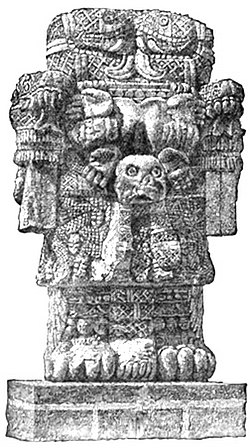well as an historical monument. Its diameter is about two and one-half meters—seven and one-half feet, while its height is perhaps four fifths of the diameter. This stone was exhumed in 1791, about one year after the Calendar Stone. It was dedicated to the sun, and has a sculptured image of the luminary on its upper face. Groups of people are seen on its convex sides, but it is blood-curdling to see that some of these are held by the hair.
In the days of its use, it is said that from twenty to fifty thousand persons were annually sacrificed on it. Prisoners of war were usually chosen as a proper sacrifice. Arrayed in gorgeous apparel, decked with flowers, and bearing in his hands musical instruments, the victim ascended the steps of the temple. He was made the bearer of orders and messages to the sun, and when at last
the stone was reached five priests bound and laid him on it, while a sixth, with a "scarlet mantle, emblematic of his bloody office, dexterously opened the breast of the wretched victim with a sharp razor, made of itztli, a volcanic substance, hard as flint, and inserting his hand, tore out the palpitating heart."
As this ancient relic now stands in the National Museum, one may recall a long past scene, by inspecting the canal cut across the top and down one side, for the blood to pass from the victim, yet writhing in his death agony.
In close proximity to the Sacrificial Stone, the Mexican Mars (called by the euphonious name of Huitzilopotchli) rears his monstrous head.

